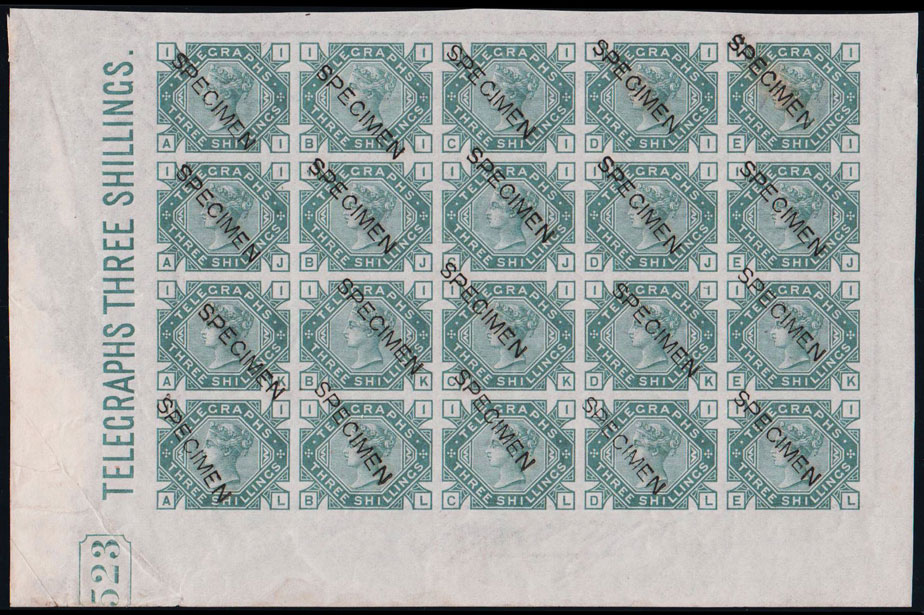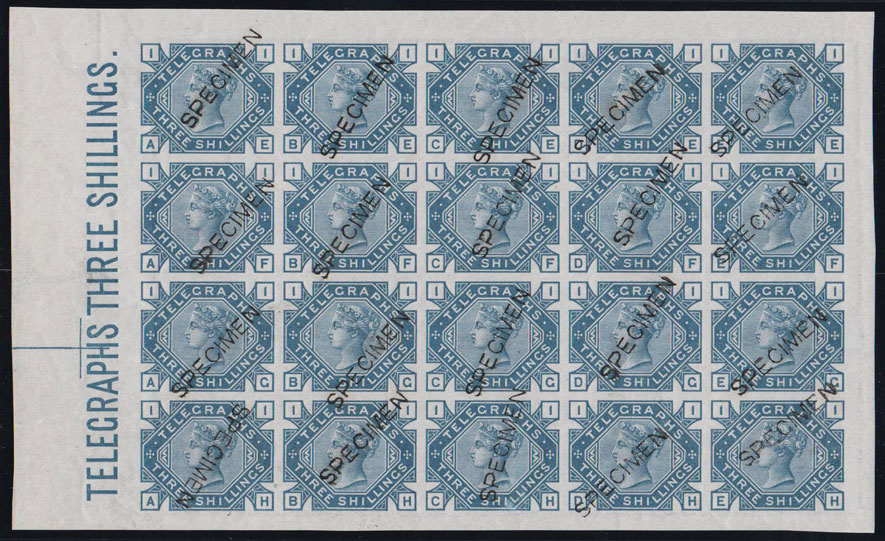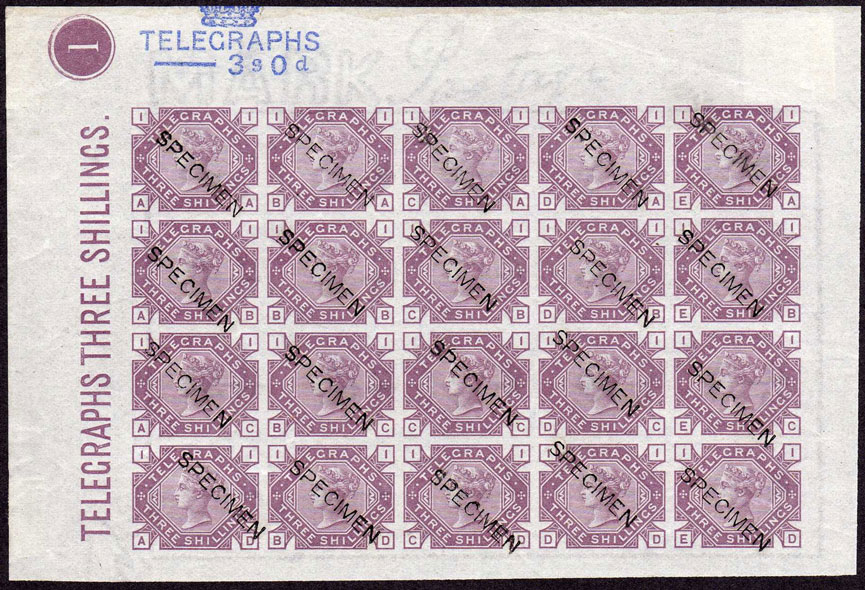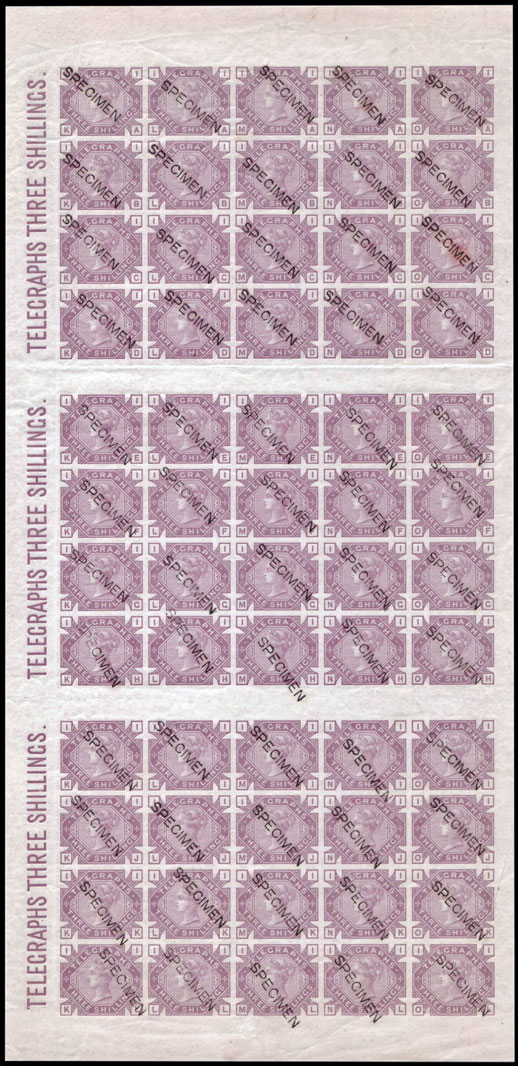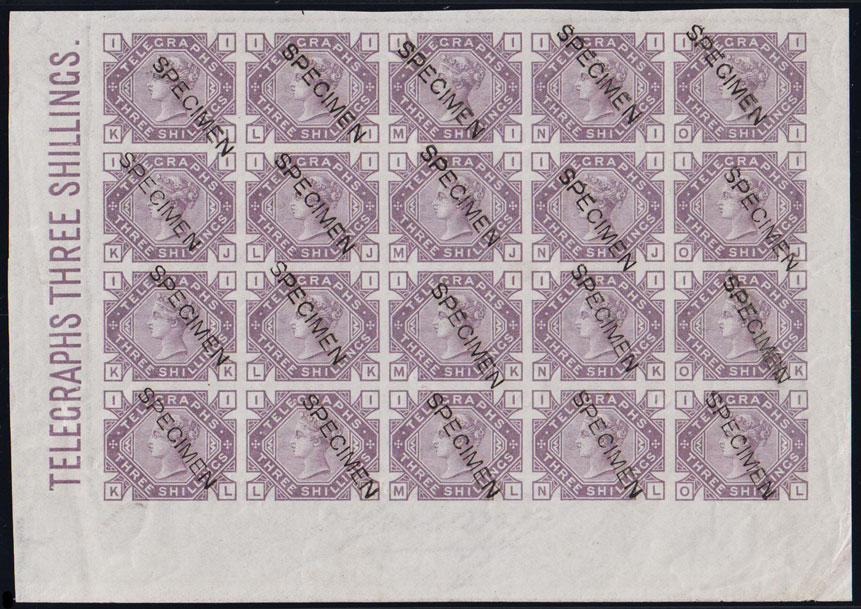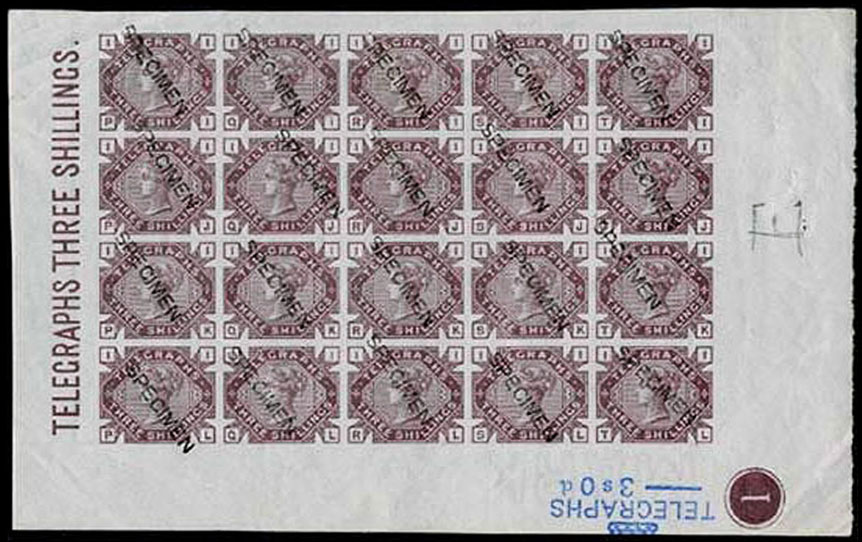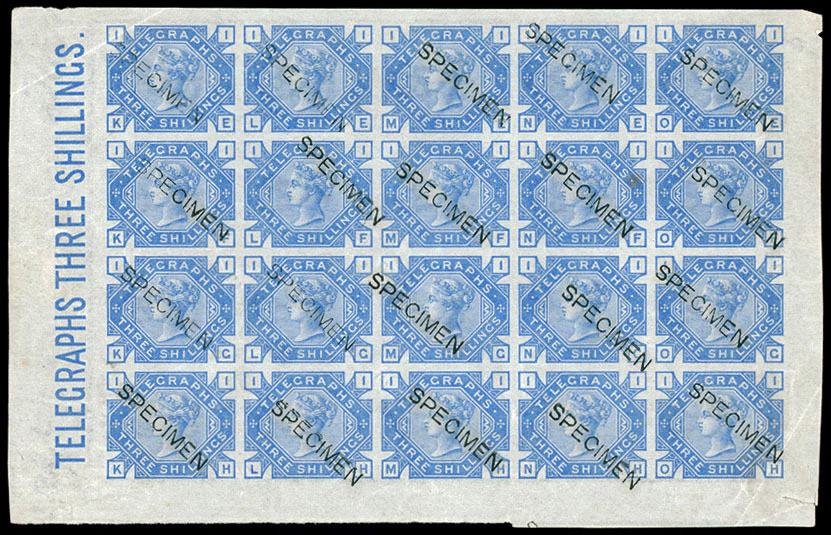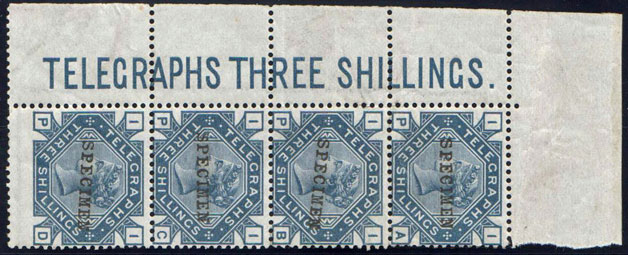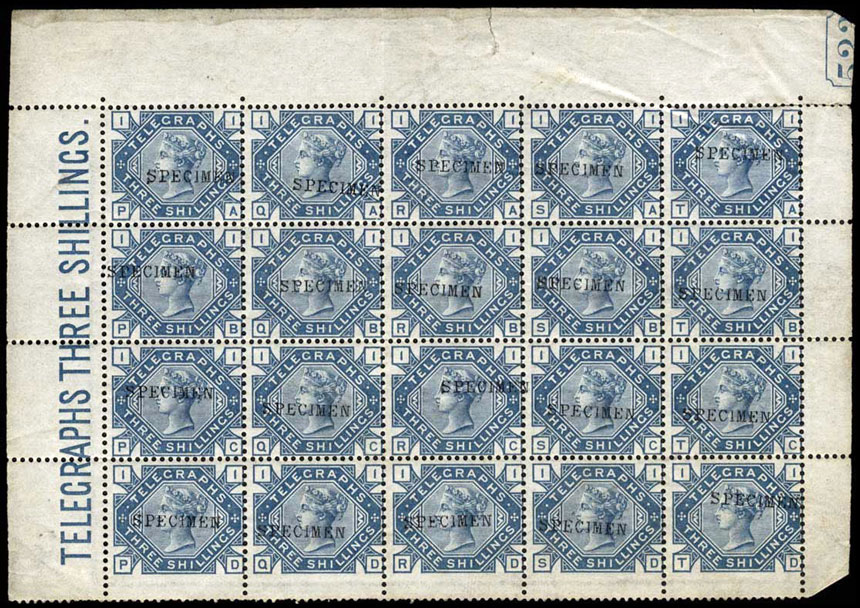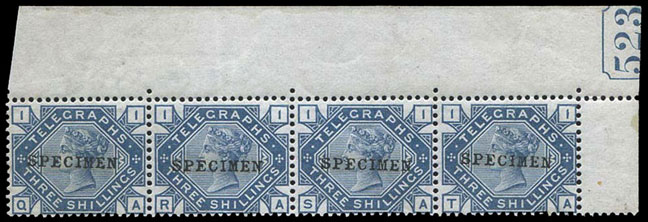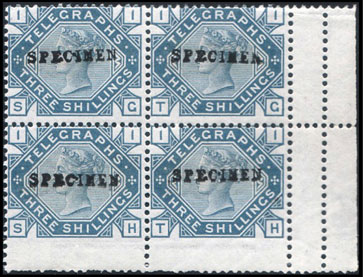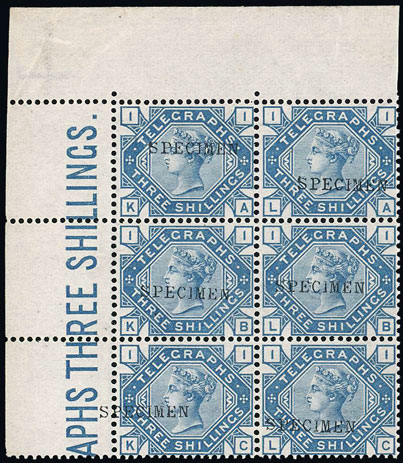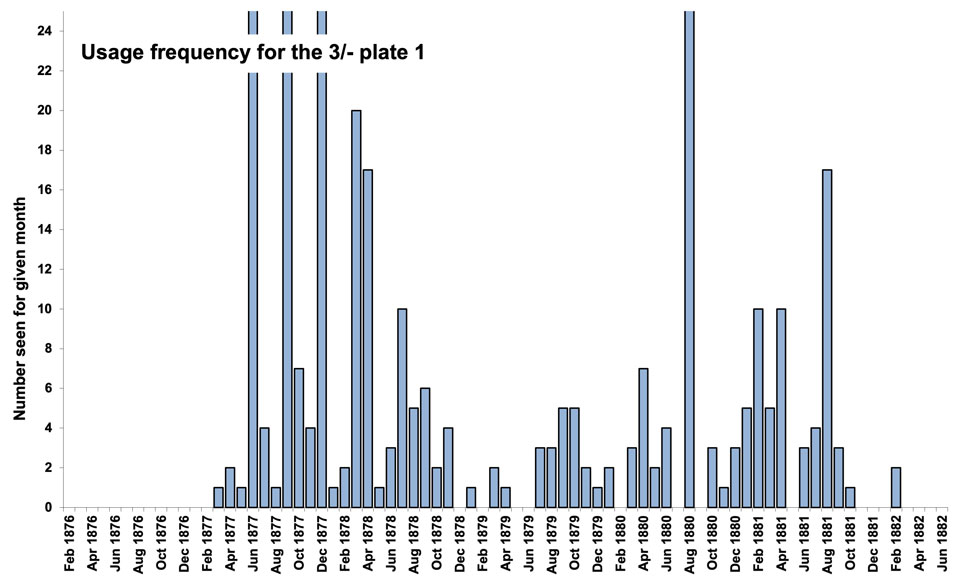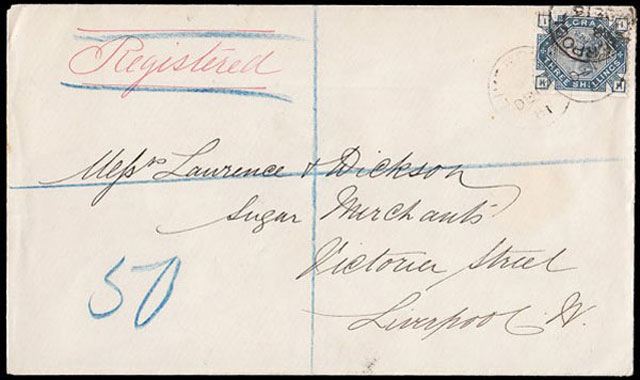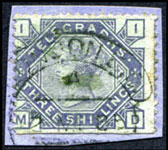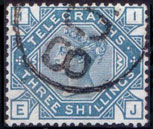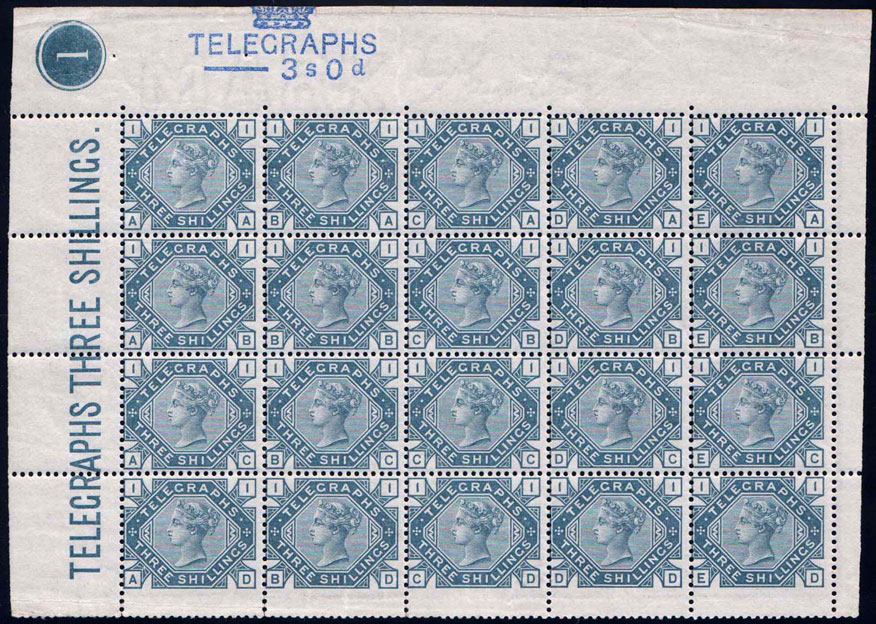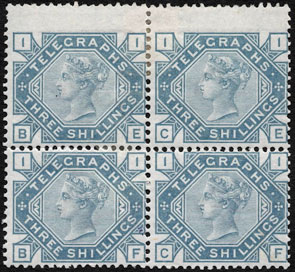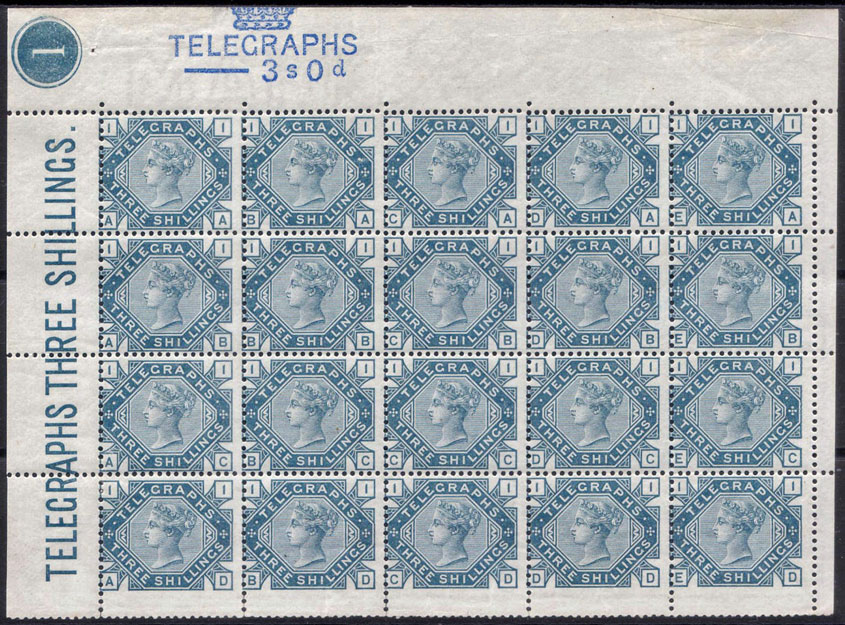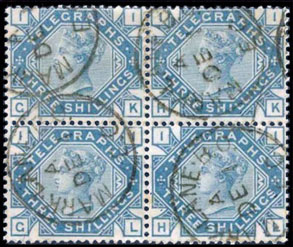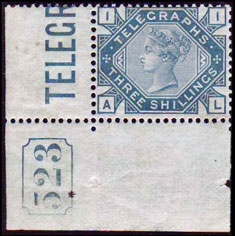1 Essays
2 Die Proofs
3 Sheet Layout
4 Plate Proofs
5 Paper
6 Colour Trials
7 Imprimaturs
8 Colour Standards
9 Specimens
10 Issued Stamps
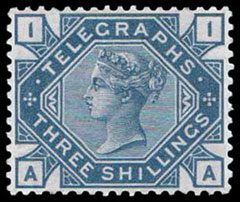
Date: 1 Mar 1877
Plates: 1
Printer: De La Rue
Watermark: Spray (sideways)
Perforation: 14
Soon after the first issue of telegraph stamps on 1 Feb 1876 there was a demand for more values. On 24 Mar 1876 the Postmaster General approved six new values: 4d, 6d, 3s, 10s, £1, and £5.
It had been decided that telegraph stamps of the same value as postage stamps would be printed in the same colour and on the same paper as the corresponding postage stamps. However, there was no corresponding 3s postage stamp, so Spray paper was chosen and trials were produced in six different colours.
One plate was prepared and registered. It was converted to Crown paper part way through its print run.
Essays
Several essays were prepared by De La Rue for the second issue, including designs lettered ‘C’ to ‘H’ and dated 21 Apr 76. Approved designs of all six values were submitted later but are undated. All of these are now in the Royal Philatelic Collection.
The lettered essays for the 3s are confusing as the design was swapped with the 4d. Also essays ‘C’ and ‘D’ were endorsed to be superseded by ‘A’ and ‘B’ but it is unclear if the latter ever existed.
| C | 3s | 77 | NN | violet, selected for the 4d |
| D | 4d | 66 | NN | red, selected for the 3s |
| — | 3s | 66 | NN | reddish purple, approved design |
For more details on second issue essays click here.
Die Proofs
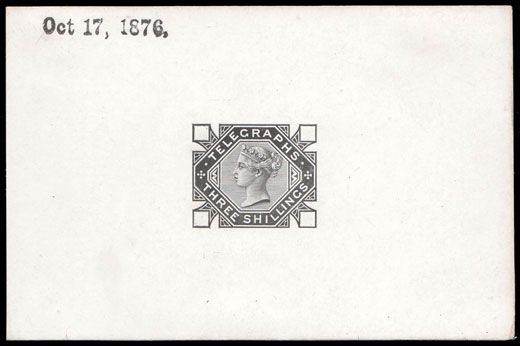
To see more 3s Die Proofs click here.
| Oct 10, 1876 | — | — | — | 1 |
| Oct 14, 1876 | — | — | “4” inverted, black spandrels | 1 |
| Oct 16, 1876 | — | — | — | 1 |
| Oct 17, 1876 | — | — | — | 3 + 1 |
| Oct 18, 1876 | — | — | — | 2 |
| Oct 19, 1876 | — | — | — | 4 + 2 |
| Oct 20, 1876 | — | — | — | 8 + 1 |
| Oct 24, 1876 | — | — | — | 4 + 1 |
| Oct 25, 1876 | — | — | — | 4 + 1 |
| Oct 26, 1876 | — | — | — | 3 + 1 |
| Oct 26, 1876 | — | — | “BEFORE HARDENING” | 7 + 1 |
| no date | — | — | Basic Die Proof | 2 + 2 |
| no date | — | — | Cut down | 1 |
From the Striking Books
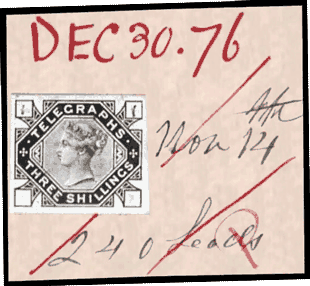
| Nov 14, 1876 | 1* | — | “Nov 14 / 240 Leads”, “Dec 30.76 / P” | 1 |
* Plate number “1” in manuscript.
In a Countersunk Frame
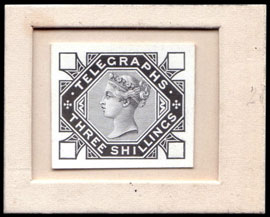
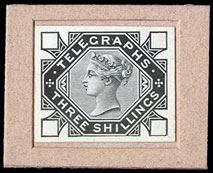
| no date | — | — | Cut down, set in a countersunk frame | 2 |
Sheet Layout
The sheet had 240 stamps in 12 panes, arranged as three rows of four. Each pane had 20 stamps in four rows of five. To the left of each pane reading upwards was “TELEGRAPHS THREE SHILLINGS.”. Plate numbers were in the upper left and lower right corners, current numbers in the lower left and upper right corners, all reading upwards. At the middle of each side was a cross used as a perforating guide.
A Post Office sheet was one pane, valued at three pounds.
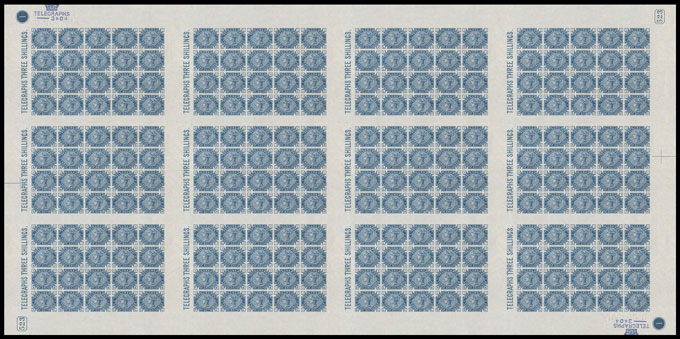
Computer generated image, click to enlarge.
Plate Proofs
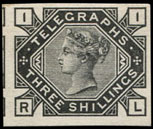
Plate proofs are known for plate 1. The reconstruction suggests there was a block of nine.
Red represents an institutionalised example.
Green a known example in private hands.
Blue is unknown but predicted by the pattern.
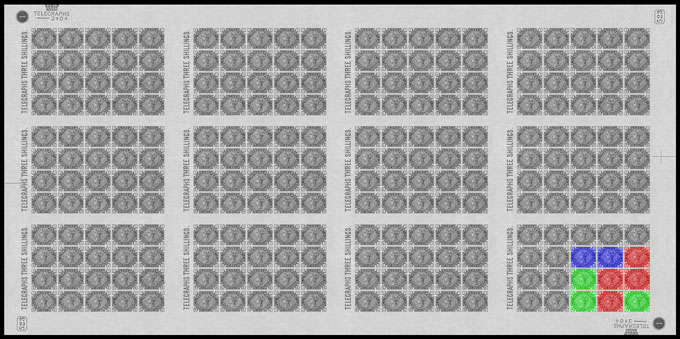
One pair is intact in the Royal Philatelic Collection: SK-TK.
TJ is in the Langmead Collection, SL is in the Phillips Collection.
TL is illustrated in Wright and Creeke with plate number attached.
Paper
The 3s telegraph stamp had no corresponding postage stamp, but as it was the same size as the 3d, 6d, and 1s stamps, it was also printed on Spray of Rose paper.
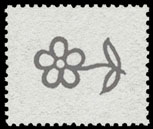
The watermark as seen from the front of the stamp.
For more details on Spray paper click here.
Colour Trials
For the second issue, colour trials were taken for all six values. They were dated “15 DEC 76”. The 3s was printed in six different colours, one sheet of each, with a letter “A” through “F” written in the sheet margin next to the datestamp, to the right of TE. Other blocks have had letters added, presumably after they were cut from the sheet.
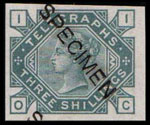
A: Grey-green
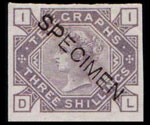
D: Dull Mauve
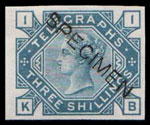
B: Slate-blue
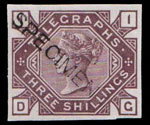
E: Brown-lilac
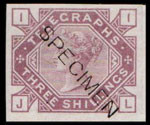
C: Dull Claret
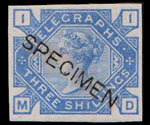
F: Pale Ultramarine
All are overprinted with Specimen Type 8 diagonal down, except for the selected colour (B: Slate-blue) which has four types of Specimen overprint all from the same sheet.
A: Grey-green
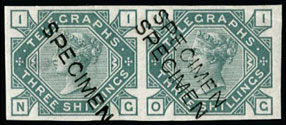
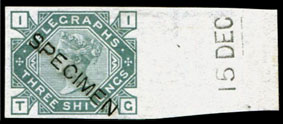
OG has a double overprint. TG shows part of the “15 DEC 76” datestamp.
Red represents an institutionalised example.
Green a known example in private hands.
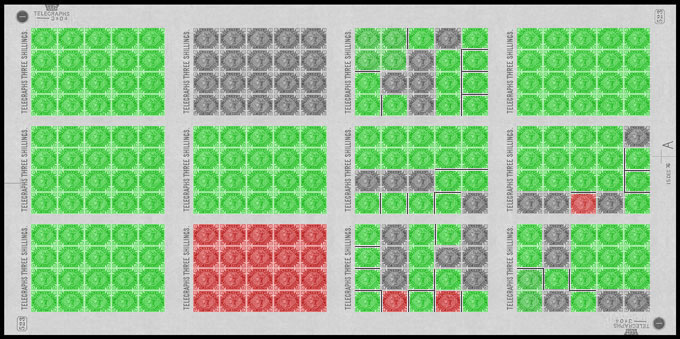
Pane FI-JL and single LL are in the Langmead Collection.
NL is in the Royal Philatelic Collection, RH in the Tapling Collection.
B: Slate-blue (Selected Colour)

Type 8 diag down
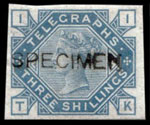
Type 8 horizontal
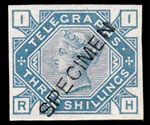
Type 8 diag up
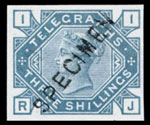
Type 11 diag up
| Type 8: | Diag Down | Horizontal | Diag Up |
| Type 11: | Diag Down | Horizontal | Diag Up |
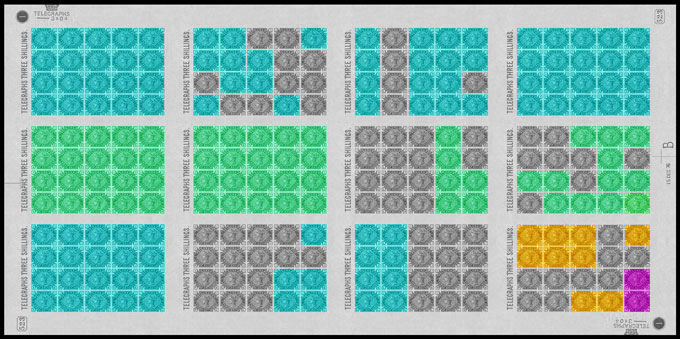
Red represents an institutionalised example.
Green a known example in private hands.
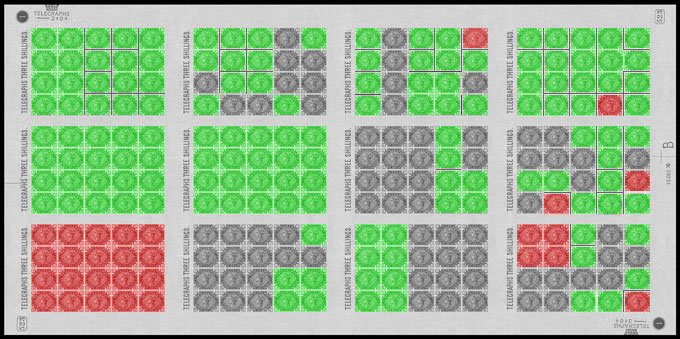
Current number pane AI-EL, block PI-QJ, and singles SD and TL are in the Langmead Collection.
TG is in the Royal Philatelic Collection, OA in the Tapling Collection, QH in the Phillips Collection.
C: Dull Claret

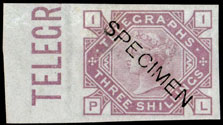
This colour is scarce as few panes have been split, and three panes are intact in one block.
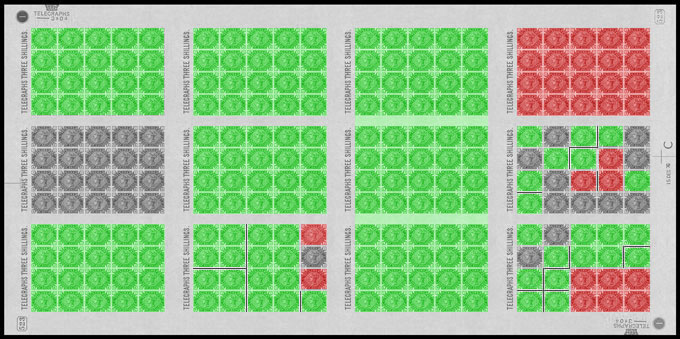
Current number pane PA-TD and single JK are in the Langmead Collection.
RG is in the Royal Philatelic Collection, JI in the Tapling Collection,
plate number block RK-TL in the Phillips Collection,
and pair SF-SG in the German Postal Museum.
D: Dull Mauve

All are overprinted with Specimen Type 8 diagonal down.
This colour tends to fade towards Dull Claret and the two are often confused.
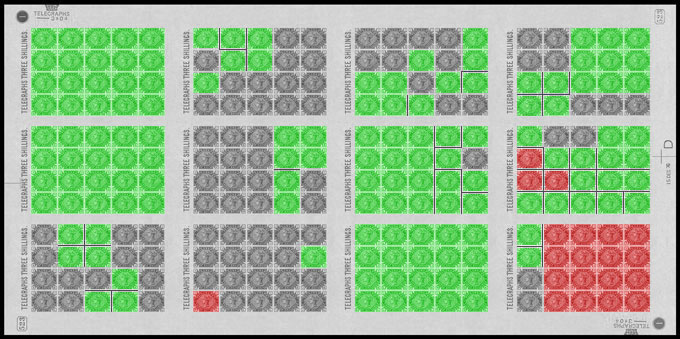
Plate number block QI-TL and single QG are in the Langmead Collection.
PG is in the Royal Philatelic Collection, FL in the Tapling Collection, PF in the Phillips Collection.
E: Brown-lilac
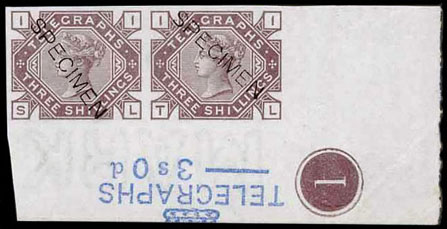
All are overprinted with Specimen Type 8 diagonal down.
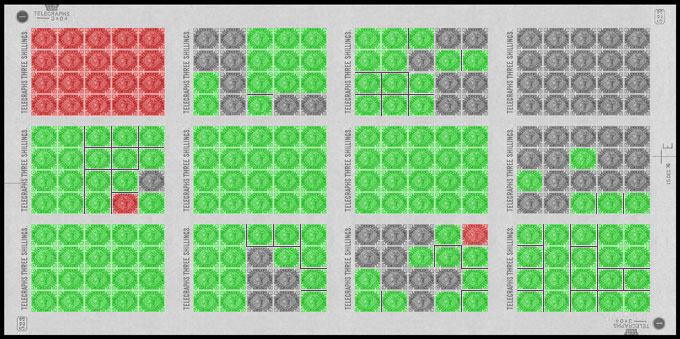
Plate number pane AA-ED and single DH are in the Langmead Collection.
OI is in the Tapling Collection.
Plate number pane PI-TL has recently been split.
F: Pale Ultramarine

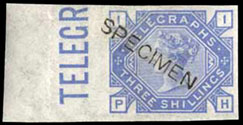
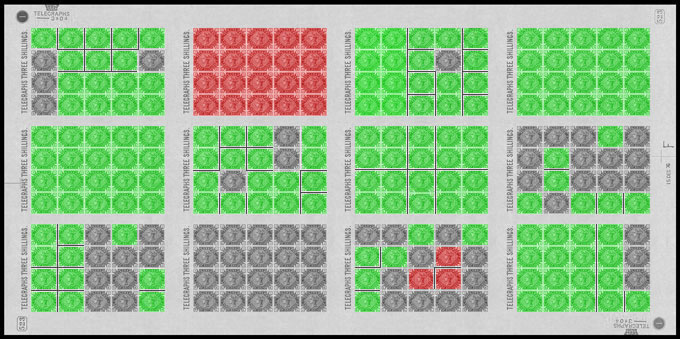
Pane FA-JD and single MK are in the Langmead Collection.
NK is in the Royal Philatelic Collection, NJ in the Phillips Collection.
Pane KE-OH has recently been split.
Colour Trial Images
Click the images to enlarge.
Imprimaturs
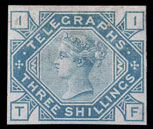
Plate 1 was registered on 12 Jan 1877.
The registration sheets for the Telegraphs have been lost. However, we can reconstruct them from known examples and a clear pattern emerges. Most have a column of 12 taken, plus four from the adjacent column, and a plate number example from the opposite corner. One sheet of each value has an extra column of 12 taken.
Red represents an institutionalised example.
Green a known example in private hands.
Blue is unknown but predicted by the pattern.
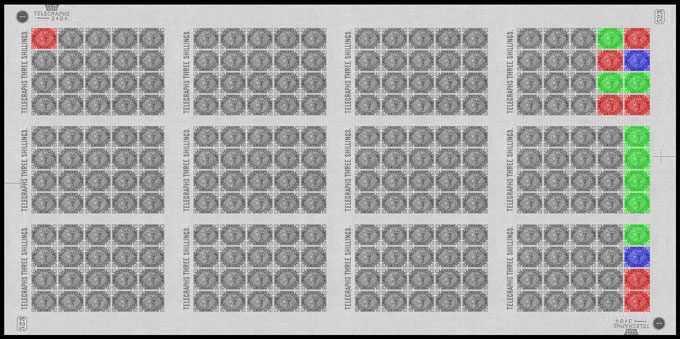
| Institutionalised/Total: | 7/17 |
| Royal Philatelic Collection: | AA, TL |
| British Postal Museum: | SB, SD |
| Tapling Collection: | TD |
| Langmead Collection: | TA |
| Phillips Collection: | TK |
Colour Standards
No colour standard sheet has been identified for the 3s, but could be one of the perforated sheets overprinted Specimen Type 9 below.
Specimens
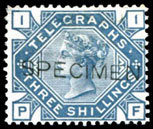
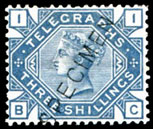
Plate 1 Type 8: rare, from 2 panes (AE-EH, PE-TH), all singles.
Plate 1 Type 11: scarce, from 2 panes (AA-ED x2), all singles.
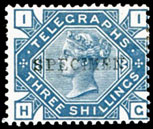
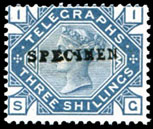
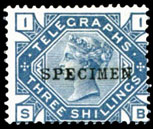
Plate 1 Type 9: common, from 9 panes (KA-OD, PA-TD x4, FE-JH x3, PD-TH), 1 pair, strip of 4, blocks of 4 (x4), 6 (x3), 16, and 2 panes of 20 PA-TD known.
Plate 1 Type 9b: common, from 7 panes (AA-ED x2, KE-OH, PE-TH x4), blocks of 4 (x2) and 15 known.
Plate 1 Type 9c: scarce, from 4 panes (PA-TD, PE-TH x3), 2 pairs, 2 strips of 4, and 1 block of 4 known.
Click the images to enlarge.
Reference to scarcity, blocks and the number of sheets or panes so treated is derived from reconstructions of known examples within our database.
Issued Stamps
Stamps were issued from one plate only. Plate 1 was converted to Crown paper part way through its print run.
The usage frequency graph shows that plate 1 was used across the whole period of the second issue.
Click the graph to enlarge.
Postal, fiscal, and railway usage are rare, with a registered cover (one of many philatelic covers sent locally to this Liverpool address), one genuine postal usage (London hooded circle), and only 855 and 1108 “English Station” railway numerals known to us.
Issued Stamps — Plate 1
Plate 1 (current no. 523) was registered on 12 Jan 1877 and put to press on 15 Jan 1877. It was re-registered on Crown paper after printing 10,000 sheets on Spray.
Scarcity #7 in mint telegraphs, #4 in used telegraphs.
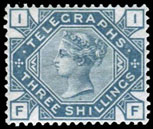
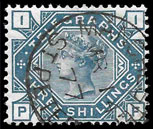
Mint multiples are common with three complete panes of 20 (two with plate number), a block of six, three blocks of four, an irregular block of three, and three pairs in our database. Singles exist with plate number and current number.
Used multiples are scarce with 18 pairs, three strips of three, and blocks of four (x3) and six known to us. The earliest known used example is 14 Mar 1877 at Manchester St Peters (illustrated).
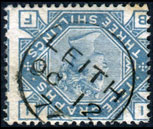
Inverted watermarks are rare. Two used singles are known to us.
Click the images to enlarge.
